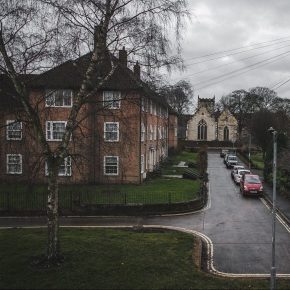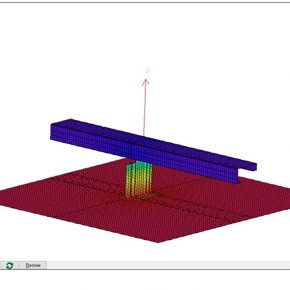
GUEST ARTICLE: From problem to progress – cracking the issue of RAAC in the residential sector
 RAAC, or Reinforced Autoclaved Aerated Concrete, has made headlines in recent years due to sudden and alarming reports of ‘crumbling concrete’. Widespread concern has followed – understandably so, as homes and schools may be at risk of structural collapse, posing a serious threat to public safety. While the true scale of the problem is still unknown, the latest government figures report 234 cases of RAAC in UK schools and colleges alone. More recently, this has extended to residential homes, as 500 Aberdeen residents were forced to move due to the possible presence of RAAC. Steve McSorley, Director at Perega, writes the following article…
RAAC, or Reinforced Autoclaved Aerated Concrete, has made headlines in recent years due to sudden and alarming reports of ‘crumbling concrete’. Widespread concern has followed – understandably so, as homes and schools may be at risk of structural collapse, posing a serious threat to public safety. While the true scale of the problem is still unknown, the latest government figures report 234 cases of RAAC in UK schools and colleges alone. More recently, this has extended to residential homes, as 500 Aberdeen residents were forced to move due to the possible presence of RAAC. Steve McSorley, Director at Perega, writes the following article…
Hope on the horizon
The situation may look grave; however, we should all find hope in the considerable skill set of the UK’s structural engineering community, which is ideally placed to tackle this urgent issue.
As well as being well-versed in building codes, regulations, and standards, including RAAC requirements, today’s structural engineers are more than capable of exceeding performance standards set by local authorities and regulatory bodies. However, to get there, the building community must also do its part and help identify issues before they escalate. This requires some knowledge and history of RAAC…
Understanding the issue
From the 1960s to the mid-1990s, RAAC was widely used in various structural applications, including ceiling and roof support beams, due to being lightweight and affordable. However, the material has a significant drawback: its susceptibility to water ingress. Over time, this leads to gradual corrosion of the steel reinforcement within the concrete, compromising its structural integrity.
Another concern is the bearings of the planks on the supporting structures, where sudden failure is possible. It’s one of the reasons buildings containing RAAC elements pose potential risks to occupants. This is made all the more difficult since the material may be concealed within a building’s fabric, making it difficult to spot.
Historic RAAC installations also bring added complexity, particularly around support systems. Previously, a minimum 50mm bearing on supporting elements was recommended, but guidance from the Institution of Structural Engineers in April 2023 advocates for a minimum of 75mm, aligning it with other precast concrete elements. This adjustment enhances load distribution, reducing stress on bearing points and lowering the risk of structural failure.
Leave it to the experts
When it comes to fixing these issues, the initial step often involves identification by an experienced IStructE-accredited professional, who can assess the structural condition of RAAC elements and devise an appropriate remediation strategy.
A comprehensive structural survey then follows to determine the extent of RAAC, and a mitigation and maintenance programme is devised to ensure the safety of residents. Due to its nature and how difficult it is to identify, it may be necessary to undertake an intrusive survey, paying close consideration to the fragility of the structure to avoid any chance of collapse.
From here there are three main courses of action, depending on the condition of the RAAC:
1) Identify well-maintained RAAC and leave it with a monitoring regime, if standards are deemed acceptable
2) Strengthen the deteriorating planks
3) Replace them if they are beyond repair
Whilst scenarios should be judged on a case-by-case basis, each approach presents unique challenges. Reinforcing RAAC may require additional support or material application for improved durability. Meanwhile, if planks need replacing then meticulous planning is needed to uphold structural integrity throughout the process.
Safeguarding the next generation
Evacuating residents from their premises during this process is a reliable safety measure and, realistically, appraisals and assessments may take six months or longer to complete.
However, whilst safeguarding all homes and schools may take some time to complete, the ‘RAAC episode’ has reinforced one of the core beliefs of the construction industry – that the welfare of building occupants should always be a top priority.
Right now, the industry has an opportunity to do better. By showcasing its commitment to protecting residents and innovation, it can avoid potentially life-threatening situations like that caused by RAAC. The good news is that today’s structural engineers are already taking the lead, creating new standards and practices, including guidelines for the assessment and remediation of RAAC, to ensure the safety of structures. Collectively, let’s learn from the past and demonstrate the true excellence of this country’s construction capabilities, building a safer future for all.
Latest news

26th July 2024
Enfield Speciality Doors completes world-class project for Atlas Copco HQ
A rundown office and warehouse building completely transformed into a modern headquarters for Atlas Copco has been fitted with more than 120 internal fire doors from Enfield Speciality Doors.
Posted in Access Control & Door Entry Systems, Articles, Building Industry News, Building Products & Structures, Building Systems, Case Studies, Doors, Interior Design & Construction, Interiors, Posts, Restoration & Refurbishment, Retrofit & Renovation, Security and Fire Protection, Sustainability & Energy Efficiency, Timber Buildings and Timber Products, Wooden products
26th July 2024
Abloy UK launches new white paper
Abloy UK, a leading provider of security and access control solutions, has launched a new white paper.
Posted in Access Control & Door Entry Systems, Architectural Ironmongery, Articles, Building Industry News, Building Products & Structures, Building Services, Doors, Facility Management & Building Services, Health & Safety, Information Technology, Innovations & New Products, Publications, Research & Materials Testing, Security and Fire Protection
26th July 2024
MCRMA Member Profile: David Roy, Director of Roofconsult
David Roy of MCRMA member company Roofconsult has more than 50 years’ experience to draw upon working in the building envelope sector and a unique perspective on how it has changed in that time.
Posted in Articles, BIM, Infrastructure & CAD Software, Building Associations & Institutes, Building Industry News, Building Products & Structures, Building Services, Building Systems, Cladding, Information Technology, Restoration & Refurbishment, Retrofit & Renovation, Roofs, Walls
26th July 2024
Strand: Enhancing Door Functionality and Safety
Craig Fox, Sales Director for Strand Hardware, outlines how door industry professionals might apply door limiting stays…
Posted in Architectural Ironmongery, Articles, Building Industry News, Building Products & Structures, Building Services, Doors, Facility Management & Building Services, Health & Safety, Restoration & Refurbishment, Retrofit & Renovation
 Sign up:
Sign up: